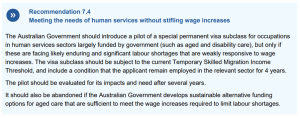Productivity Commission report backs greater public contributions to combat aged care workforce shortages – again
The Federal Government’s key advisory body has recommended a new ‘stop-gap’ visa class for overseas aged care workers – but says a new “sustainable” funding model for the sector could help to overcome the challenge of attracting workers...

The Federal Government’s key advisory body has recommended a new ‘stop-gap’ visa class for overseas aged care workers – but says a new “sustainable” funding model for the sector could help to overcome the challenge of attracting workers. Released last Friday, the Productivity Commission’s 1,019-page, nine-volume ‘Advancing Prosperity’ report makes 71 recommendations aimed at growing Australia’s economy and increasing the prosperity of individuals around five key themes:
- Building an adaptable workforce.
- Harnessing data and digital technology.
- Creating a more dynamic economy by fostering competition and efficiency.
- Lifting productivity in the “non-market sector” – including care services; and
- Transitioning to net zero at the lowest cost.
Key to their policy advice is the need to improve the efficient delivery of care services. The report notes that while 30% of aged care workers are migrants, less than 1% are sponsored for employment in the sector. Instead, 38% of migrants in care services are on student visas and come into the sector as ‘sideways entrants’. Currently, only aged care Registered Nurses are listed on the Department of Home Affairs’ Priority Migration Skilled Occupation List. In response, the Productivity Commission recommends that the Government establish a new special permanent visa subclass for aged and disability care workers. This visa subclass should be a pilot, the report argues, and include a condition that the applicant needs to remain employed in the relevant sector for four years.
Co-contributions would sidestep Government funding shortfall

Perhaps more interestingly however, the Productivity Commission adds that the scheme “should also be abandoned if the Australian Government develops sustainable alternative funding options for aged care that are sufficient to meet the wage increases required to limit labour shortages.” “One measure that could sidestep the fiscal constraints Governments face in meeting growing needs for aged care services would be a new model designed to ensure sustainable funding of aged care,” it states. “In its report into Australia’s aged care system, the Productivity Commission proposed re-balancing public and private contributions to create a sustainable source of revenue (PC 2011a, chapter 8).” “There are alternatives that could achieve similar outcomes, such as a universal competitive mandatory insurance scheme (Ergas and Paolucci 2011).” “The formula determining the combined private and public funding could be set at a level sufficient to pay the wages to attract workers to aged care from either Australian citizens or, where wages were high enough, from the new skilled visa streams.”
In short, a re-weighting of the funding model towards a higher level of consumer contributions would likely negate the need for the new visa. 12 years after the Productivity Commission first recommended greater consumer contributions, is this recommendation finally about to come to fruition?





